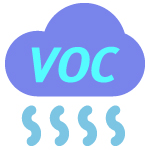The aerospace industry is growing rapidly. Many companies have found themselves facing the predicament of what to do about volatile organic compounds (VOCs). These substances can pose a health threat to workers. They are subject to strict regulation under regional and international law, and the aerospace industry is one of the biggest emitters.
While increased production has traditionally meant higher VOC emissions, this doesn’t have to be the case. There are many productive ways to reduce VOC emissions. That’s the topic we intend to explore in this article. We’ll review the definition of VOCs and discuss applicable regulations.


What are volatile organic compounds?
Volatile organic compounds are volatile chemicals that can spread easily. They harm the indoor air quality of factories or offices. For that reason, these compounds pose some health risks to workers as well as environmental threats.
The most common VOCs are butane, toluene, ethanol, acetone and benzene. They are used in industrial processes and can be found in paint, ink, or cleaning products.
The VOC rate of a product can be measured either as a percentage of the product’s total weight or in grams of VOC per litre of the product. Butyl acetate, for example, is 100% VOC or 886 g/litre.


What laws and regulations apply to VOCs?
Companies around the world are subject to international, regional, and national regulations related to VOCs.
International regulations:
The two relevant international protocols are the Geneva Protocol and the Gothenburg Protocol. A major component of the Geneva Protocol aims to reduce emissions of different polluting materials (including VOCs) that are apt to travel across borders. The Gothenburg Protocol targets mainly pollution of lakes, rivers, and other bodies of water. It also deals with ground-level ozone pollution, which can include VOCs.
European regulations:
There are several European Union directives relate to VOCs.
- Directive 96/61/EC standardises the rules for prevention and control of pollution arising from industries such as energy, metal production and processing, mining, chemical production, and others.
- Directive 1999/13/EC sets limits on VOC emissions and outlines ways for companies to comply with VOC regulations.
These first two directives have been integrated into Directive 2010/75/EU. It is now the key component of European law related to regulation of companies’ VOC emissions.
- Directive 2001/81/EC fixes national emission ceilings for certain atmospheric pollutants. It includes VOCs, according to the standards of the Gothenburg Protocol.
U.S. regulations:
Federal VOC regulations in the United States fall under the auspices of 40 CFR 59. The Environmental Protection Agency sets VOC emission standards. It establishes labeling, reporting, and record keeping requirements for different products.
Yet, regulations also vary by state. Most states are required to meet the minimum level of stringency referred to as Reasonably Available Control Technology (RACT). Some states, like Maryland, Connecticut, and California, have more stringent regulations than federal law requires.
Canadian regulations:
Canada has regulated VOCs since 2003. The relevant current regulations were instituted following a 2010 discussion paper published by Environment Canada. It meant to rejuvenate the federal agenda on VOCs. In 2012, Canadian authorities agreed to put in place tougher air quality measures with a comprehensive new Air Quality Management System (AQMS).
Chinese regulations:
Since 2015, China has instituted a system of control policies geared toward moving companies away from VOC use. The system includes:
- guidance for companies on pollution control,
- environmental standards,
- a “clean production” audit,
- pollution fees for high VOC emitters,
- an environmental tax,
- a 10-point action plan for preventing and controlling air pollution.
French regulations:
The relevant ministerial order regulating VOC emissions in France is Arrêté du 29 mai 2000. This order updates an earlier order, Arrêté du 2 février 1998, to comply with European Directive 1999/13/EC. This directive is a fundamental on 3 levels:
- value reference for evaporation limits,
- the solvent management plan,
- the emission control plan.
